CADILLAC ELDORADO 1997 10.G Owners Manual
Manufacturer: CADILLAC, Model Year: 1997, Model line: ELDORADO, Model: CADILLAC ELDORADO 1997 10.GPages: 361, PDF Size: 22.85 MB
Page 281 of 361
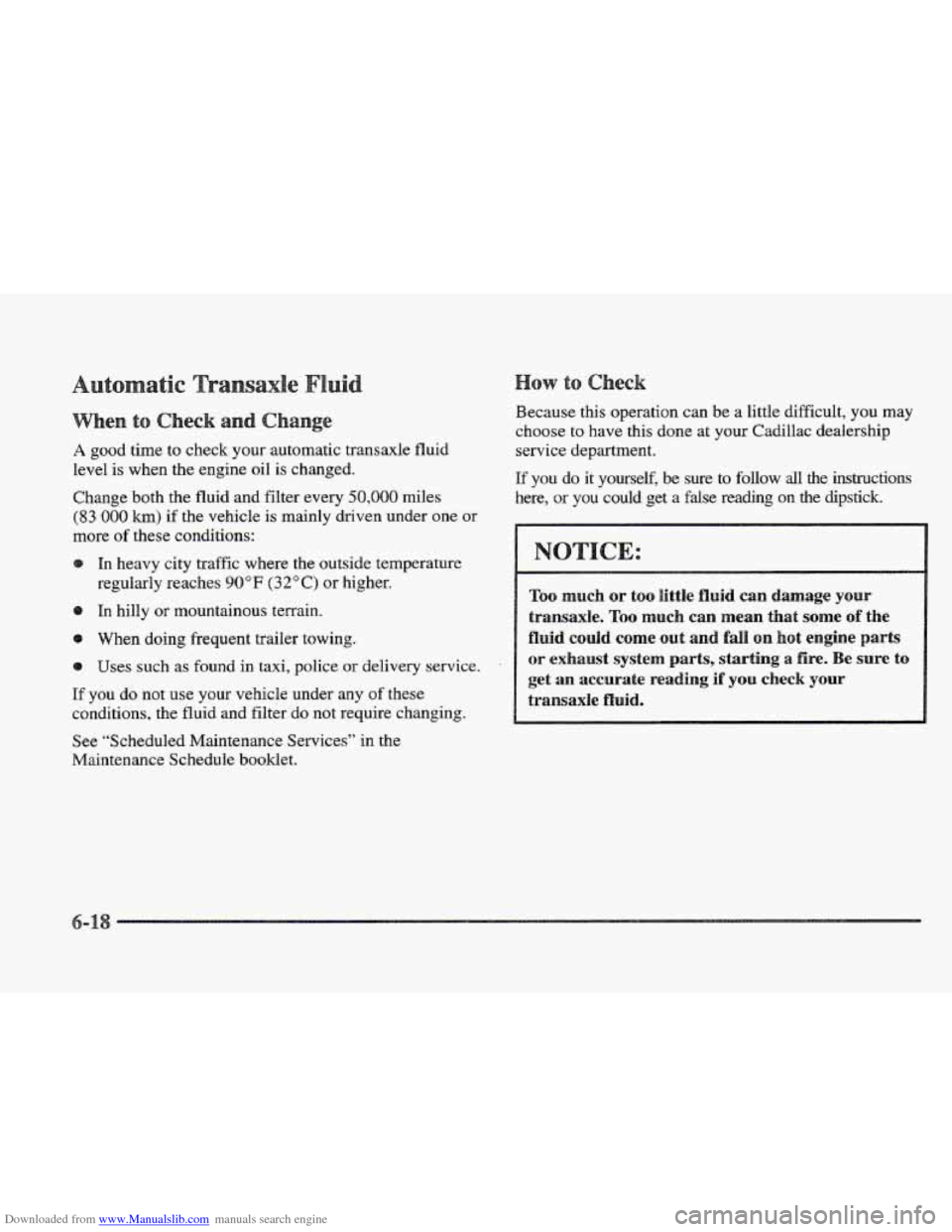
Downloaded from www.Manualslib.com manuals search engine ic
ange
A good time to check your automatic transaxle fluid
level
is when the engine oil is changed.
Change both
the fluid and filter every 50,000 miles
(83
000 km) if the vehicle is mainly driven under one or
more
of these conditions:
In heavy city traffic where the outside temperature
regularly reaches
90°F (32 O C) or higher.
In hilly or mountainous terrain.
When doing frequent trailer towing.
Uses such
as found in taxi, police or delivery service.
If you do not use your vehicle under any of these
conditions, the fluid and filter do not require changing.
See “Scheduled Maintenance Services”
in the
Maintenance Schedule booklet. Because this
operation can be
a little difficult, you may
choose
to have this done at your Cadillac dealership
service department.
If’ you do it yourself, be sure to follow all the instructions
here, or you could get
a false reading on the dipstick.
ICE:
Page 282 of 361
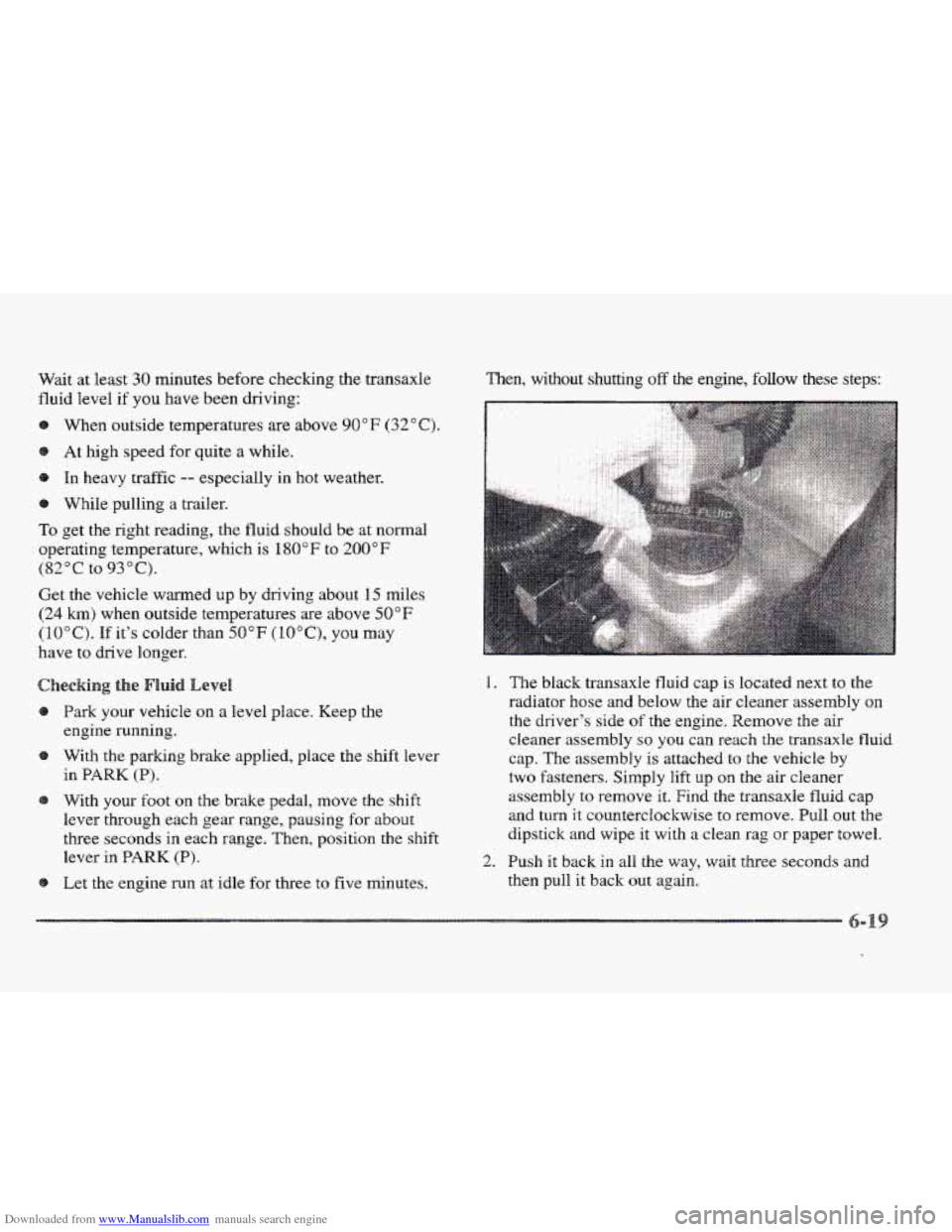
Downloaded from www.Manualslib.com manuals search engine Wait at least 30 minutes before checking the transaxle
fluid Bevel
if you have been driving:
When outside temperatures are above
90" F (32 " C).
At high speed for quite a while.
In heavy traffic
-- especially in hot weather.
While pulling
a trailer.
To get the right reading, the fluid should be at normal
operating temperature, which
is 180°F to 200" F
(82°C to 93°C).
Get the vehicle warmed up by driving about 15 miles
(24 km) when outside temperatures are above 50°F
(10°C). If it's colder than 50°F ( 10°C), YSU may
have to drive longer.
Park your vehicle on a level place. Keep the
engine running.
With the parhng brake applied, place the shift
lever
in PARK (P).
With your foot on the brake pedal, move the shift
lever through each gear range, pausing for about
three seconds
in each range. Then, position the shift
lever in
PARK (P).
Let the engine run at idle for three to five minutes. Then, without shutting
off the engine, follow these steps:
1.
2.
The
black transaxle fluid cap is located next to the
radiator hose and
below the air cleaner assembly on
the driver's side of the engine. Remove the air
cleaner assembly
so you can reach the transaxle fluid
cap. The assembly
is attached to the vehicle by
two fasteners. Simply lift up on the air cleaner
assembly to remove it.
Find the transaxle fluid cap
and
turn it counterclockwise to remove. Pull out the
dipstick and wipe it with
a clean rag or paper towel.
Push it back in all the way, wait three seconds and
then pull it back out again.
Page 283 of 361
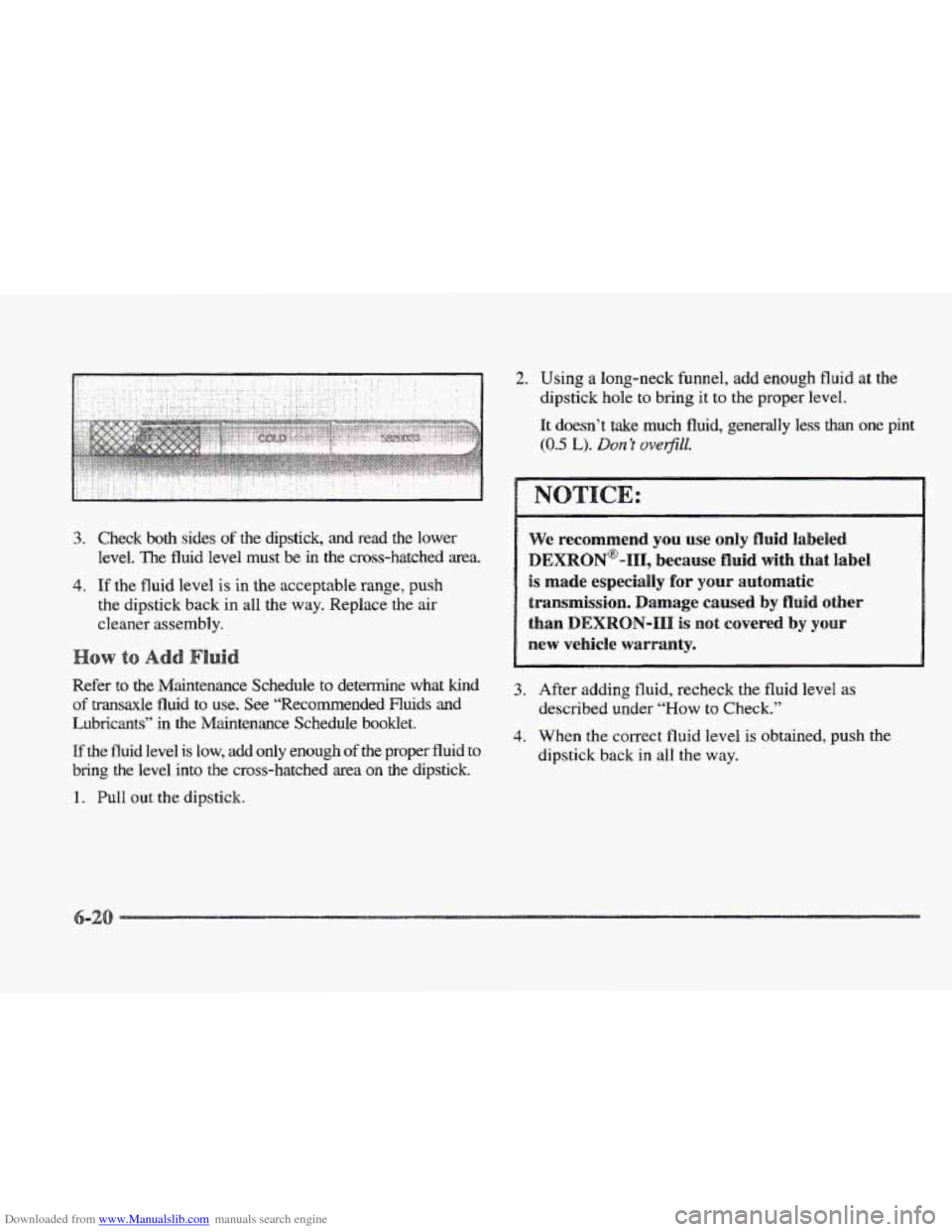
Downloaded from www.Manualslib.com manuals search engine 3. Check both sides of the dipstick, and read the lower
level.
”he fluid level must be in the cross-hatched area.
4. If the fluid level is in the acceptable range, push
the dipstick back in
a11 the way. Replace the air
cleaner assembly.
Refer
to the Maintenance Schedule to determine what kind
of transaxle fluid to use. See “Recommended Fluids and
Lubricants” in the Maintenance Schedule booklet.
If’ the fluid level is low, add only enough of the proper fluid to
bring the level into the cross-hatched area on the dipstick.
1. Pull OW the dipstick.
2. Using a long-neck funnel, add enough fluid at the
dipstick hole to bring it to the proper level.
It doesn’t take
much fluid, generally less than one pint
(0.5 L). Don’t oveflll.
3. After adding fluid, recheck the fluid level as
described under “How to Check.”
4. When the correct fluid level is obtained, push the
dipstick back
in all the way.
Page 284 of 361
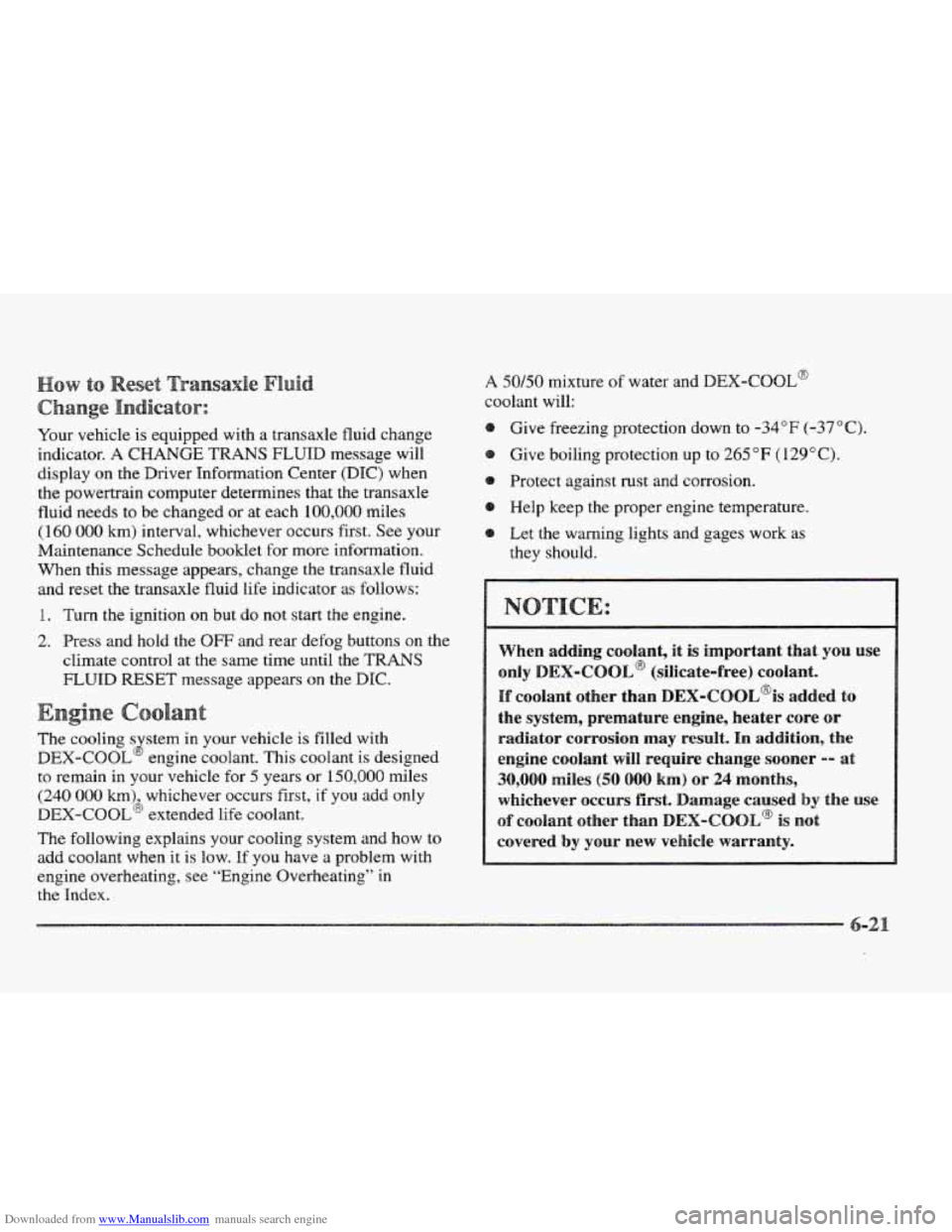
Downloaded from www.Manualslib.com manuals search engine Your vehicle is equipped with a transaxle fluid change
indicator.
A CHANGE TRANS FLUID message will
display on
the Driver Information Center (DIC) when
the powertrain computer determines that the transaxle
fluid needs to be changed or at each
100,080 miles
(160 080 km) interval, whichever occurs first. See your
Maintenance Schedule booklet for more information.
When this message appears, change the transaxle fluid
and reset the transaxle fluid life indicator as follows:
I. Turn the ignition on but do not start the engine.
2. Press and hold the OFF and rear defog buttons on the
climate control at the same time until the
TRANS
FLUID RESET message appears on the DHC.
The cooling s stern in your vehicle is filled with
DEX-COOL engine coolant. This coolant is designed
to remain
in your vehicle for 5 years or 150,000 miles
(240 000 km) whichever occurs first, if you add only
DEX-COOL‘ extended life coolant.
2
The following explains your cooling system and how to
add coolant when
it is low. If YOU have a problem with
engine overheating, see “Engine Overheating”
in
the Index.
A 50/50 mixture of water and DEX-COOL@
coolant will:
@ Give freezing protection down to -34” F (-37°C).
Give boiling protection up to 265 OF (1 29°C).
Protect against rust and corrosion.
Help keep the proper engine temperature.
Let the warning lights and gages work as
they should.
When adding coolant, it is important that you use
only DEX-COOL~ (silicate-free) coolant.
If coolant other than DEX-COOL@is added t~
the system, premature engine, heater core or
radiator corrosion may result. In addition, the
engine coolant
will require change SOQWW 0- at
34b,8(Bo miles (50 000 km) or 24 months,
whichever CD~CUP’S first. Damage caused
of coolant other than
covered
by your new vehicle warranty.
Page 285 of 361
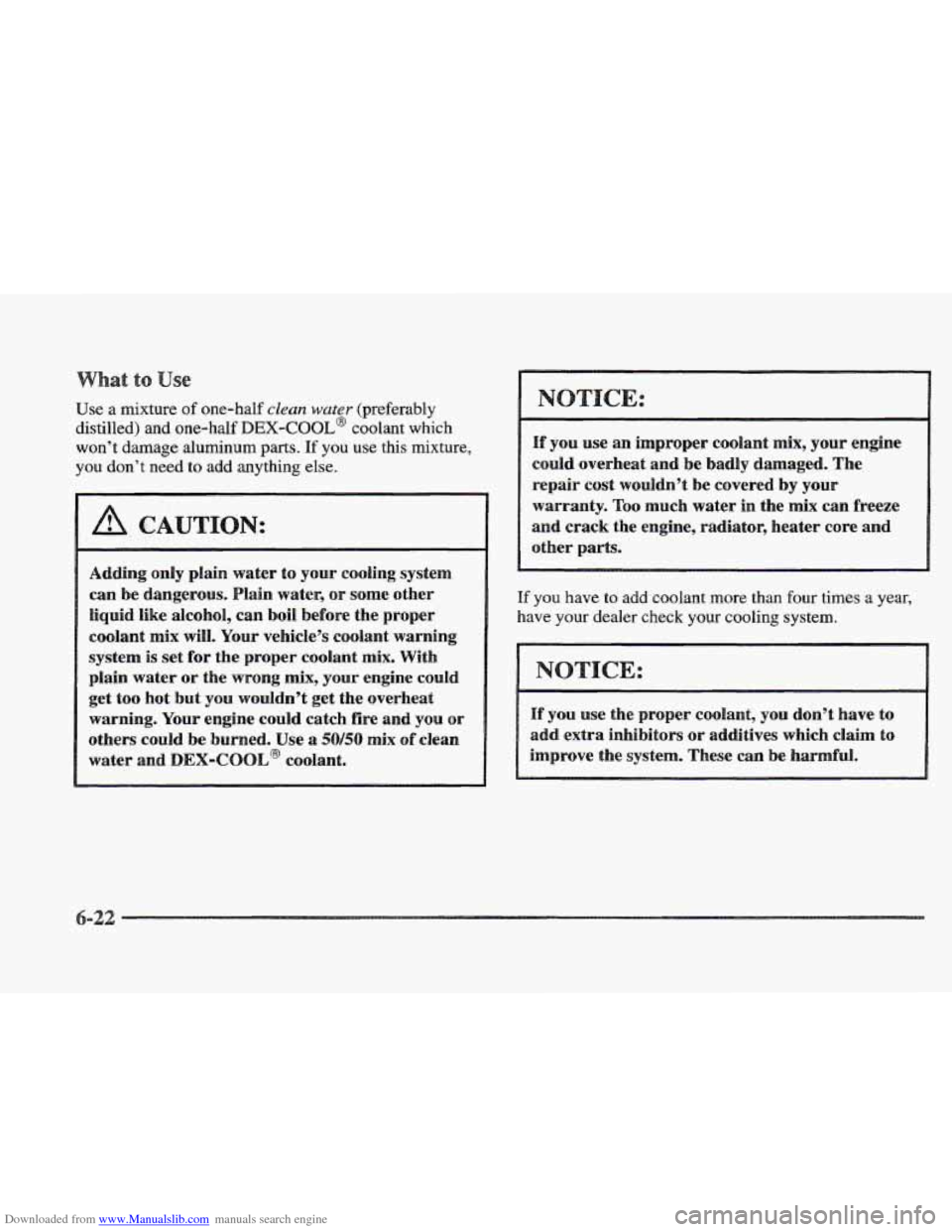
Downloaded from www.Manualslib.com manuals search engine Use a mixture of one-half clean water (preferably
distilled) and
one-half DEX-COOL@ coolant which
won’t damage aluminum
parts. If you use this mixture,
you
don’t need to add anything else.
A, CAUTION.: ..
Adding only plain water to your cooling system
can
be dangerous. Plain water, or some other
liquid Bike alcohol, can boil before the proper
coolant mix will.
YQW vehicle’s coolant warning
system is set for the proper coolant mix. With
plain water or the wrong
mix, your engine could
get too hot but you wouldn’t get the overheat
warning. Your engine could catch fire and
YOU or
others could
be burned. Use a 5W50 mix of clean
water and
DEX-COOE~ coolant.
If YSU use an improper coolant mix, your engine
could overheat and
be badly damaged. The
repair cost wouldn’t be covered by your
warranty. Too much water in the mix can freeze
and crack the engine, radiator, heater core and
If you have to add coolant more than four times a year,
have your dealer check your cooling system.
If you use the proper coolant, you don’t have to
add extra inhibitors
QF additives which claim to
improve the system. These can be harmful.
Page 286 of 361
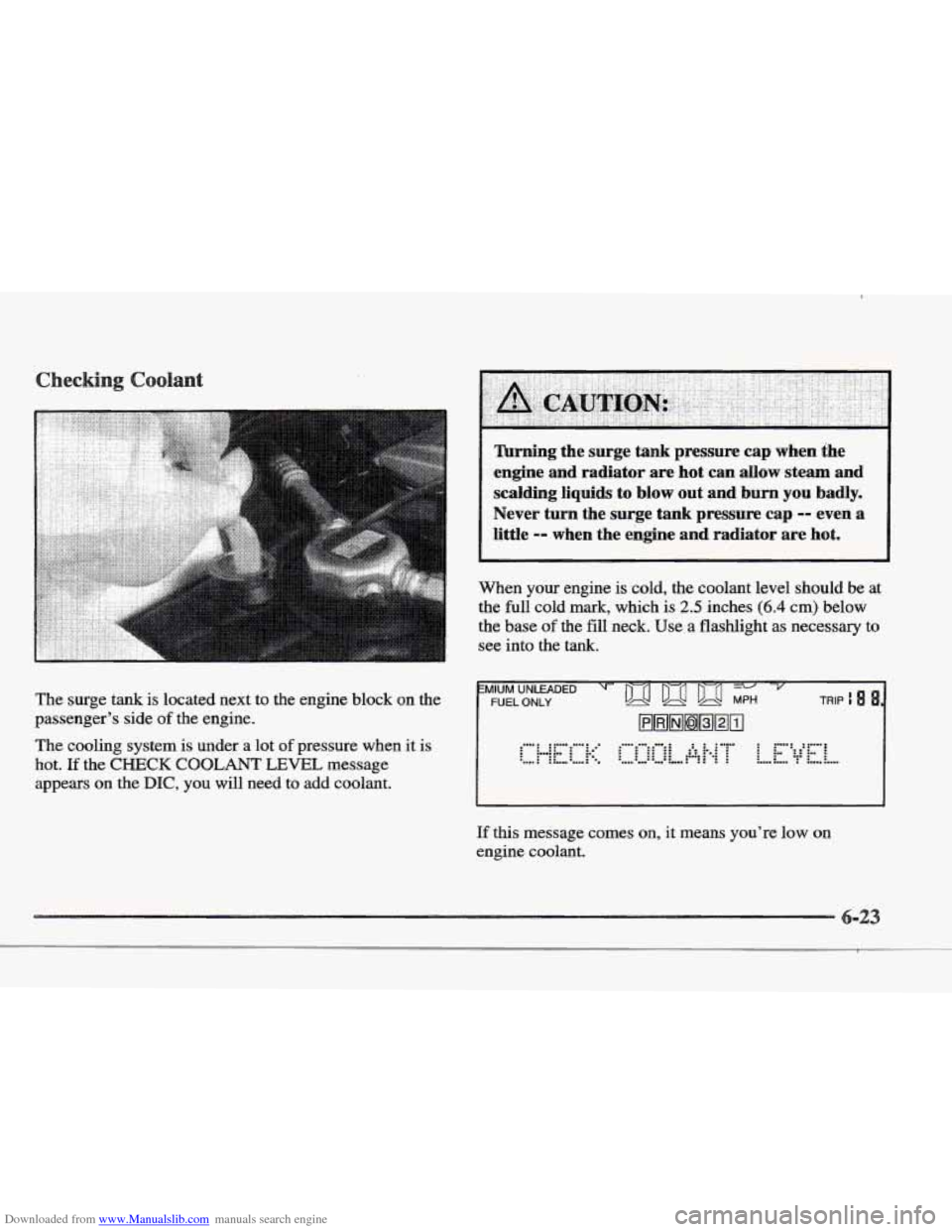
Downloaded from www.Manualslib.com manuals search engine The surge tank is located next to the engine block on the
passenger's side
of the engine.
The cooling system is under a lot
of pressure when it is
hot. If the CHECK COOLANT LEVEL message
appears on the
DIC, you will need to add coolant.
Turning the surge tank pressure cap when the
engine and radiator are hot can allow steam and
scalding liquids to blow out and burn you badly.
Never
turn the surge tank pressure cap =- even a
little -- when the engine and radiator are hot.
When your engine is cold, the coolant level should be at
the full cold mark,
which is 2.5 inches (6.4 cm) below
the base
of the fill neck. Use a flashlight as necessary to
see into the
tank.
MlUM UNLEADED - -
FUEL ONLY
DS Dg a ML
HHBHBBrn
........... ....... ." .......................... ...... ....... , : :: :: .-. :. : : ............. :.no. ... ..... : :L...-"..: ".L... ..... .............. .....
.... ...... ............ . .. . .I ......... .... . . -. . . .".. .".. .I.. ..". ." ...
If this message comes on, it means you're low on
engine
coolant.
Page 287 of 361
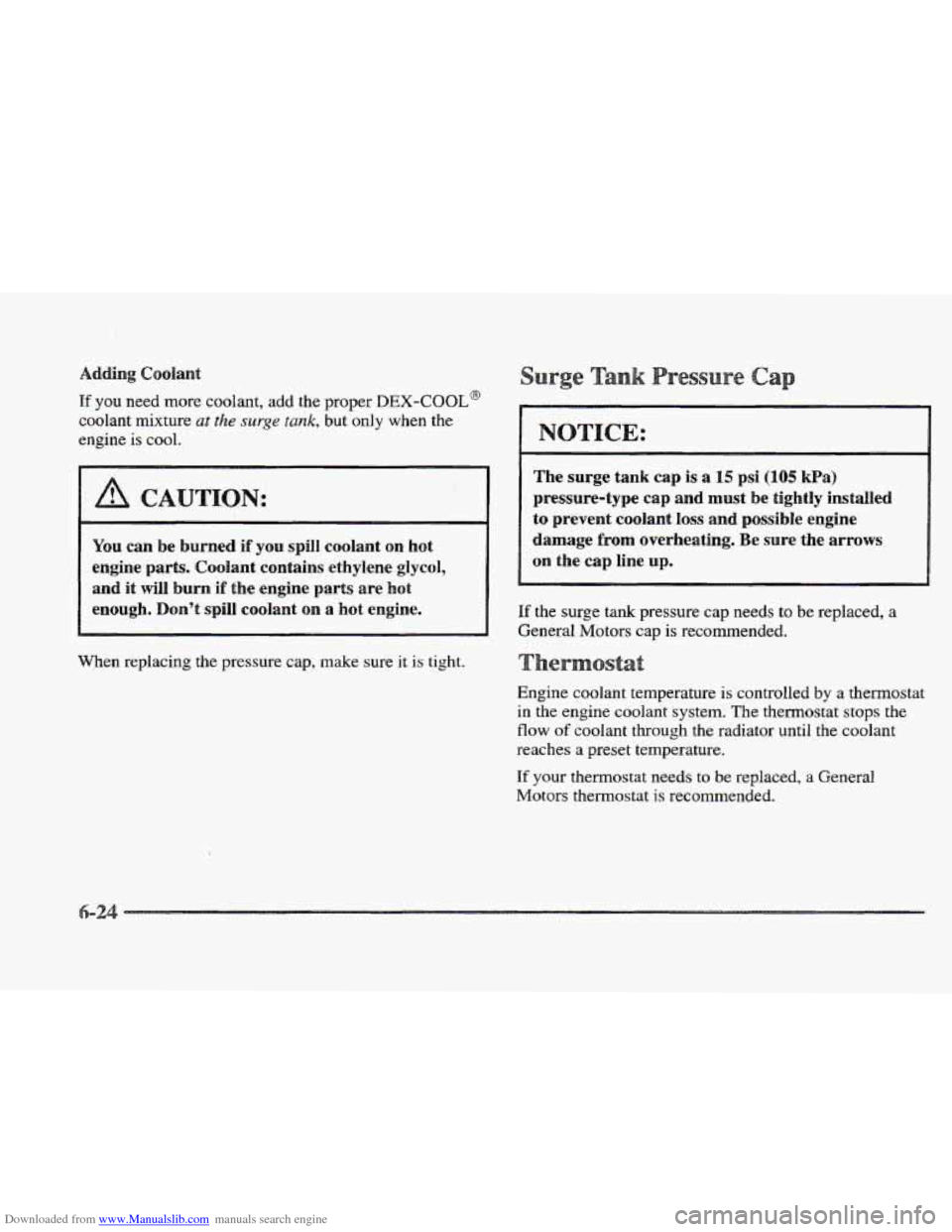
Downloaded from www.Manualslib.com manuals search engine Adding Coolant
If you need more coolant, add the proper DEX-COOL@
coolant mixture at the surge tmk, but only when the
engine is cool.
You can be burned if you spill coolant on hot
engine parts. Coolant contains ethylene
glycol,
and it will burn if the engine parts are hot
enough.
Don’t spill coolant on a hot engine.
When replacing the pressure cap, make sure it is tight.
The surge tank cap is a I§ psi (105 ma)
pressure-type cap and must be tightly installed
to prevent coolant loss and possible engine
damage from overheating. Be
sure the arrows
If the surge tank pressure cap needs to be replaced, a
General Motors cap is recommended.
e
Engine coolant temperature is controlled by a thermostat
in the engine coolant system. The thermostat stops the
flow of coolant through the radiator until the coolant
reaches a preset temperature.
If your thermostat needs to be replaced, a General
Motors thermostat is recommended.
-2
Page 288 of 361
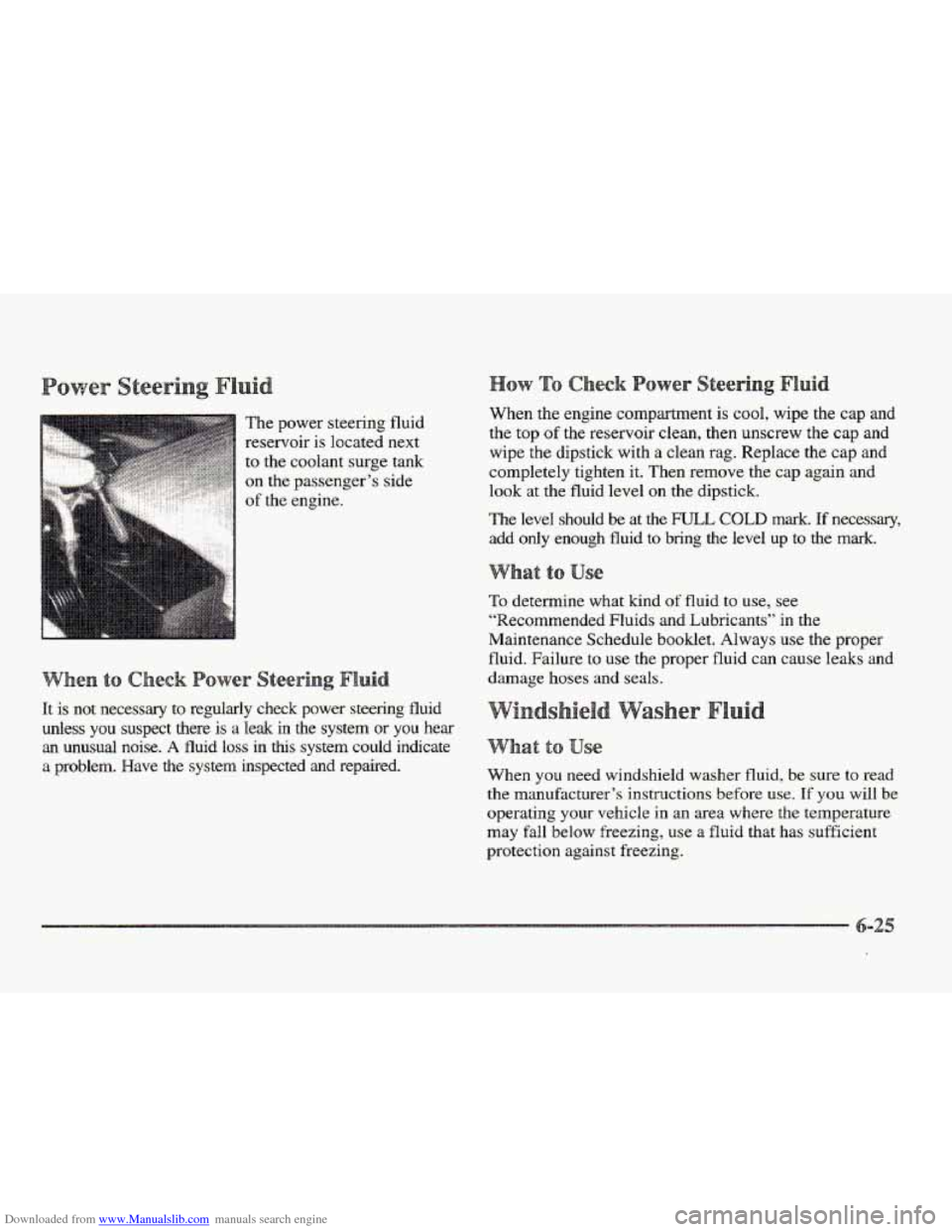
Downloaded from www.Manualslib.com manuals search engine The power steering fluid When the engine compartment is cool,
wipe the cap and
the top
of the reservoir clean, then unscrew the cap and
wipe
the dipstick with a clean rag. Replace the cap and
completely tighten
it. Then remove the cap again and
look
at the fluid level on the dipstick.
The level should be at
the FULL COLD mark. If necessary,
add only enough fluid to bring the level up to the mark.
ec
It is not necessary to regularly check power steering fluid
unless you suspect there is a leak
in the system or you hear
an unusual noise. A fluid loss in thls system could indicate
a problem. Have the system inspected and repaired.
To determine what lund of fluid to use, see
“Recommended Fluids
and Lubricants” in the
Maintenance Schedule booklet. Always use
the proper
fluid. Failure to use
the proper fluid can cause leaks and
damage hoses and seals.
When
YOU need windshield washer fluid, be sure to read
the manufacturer’s instructions before use. If you will be
operating your vehicle
in an area where the temperature
may fall
below freezing, use a fluid that has sufficient
protection against freezing.
Page 289 of 361
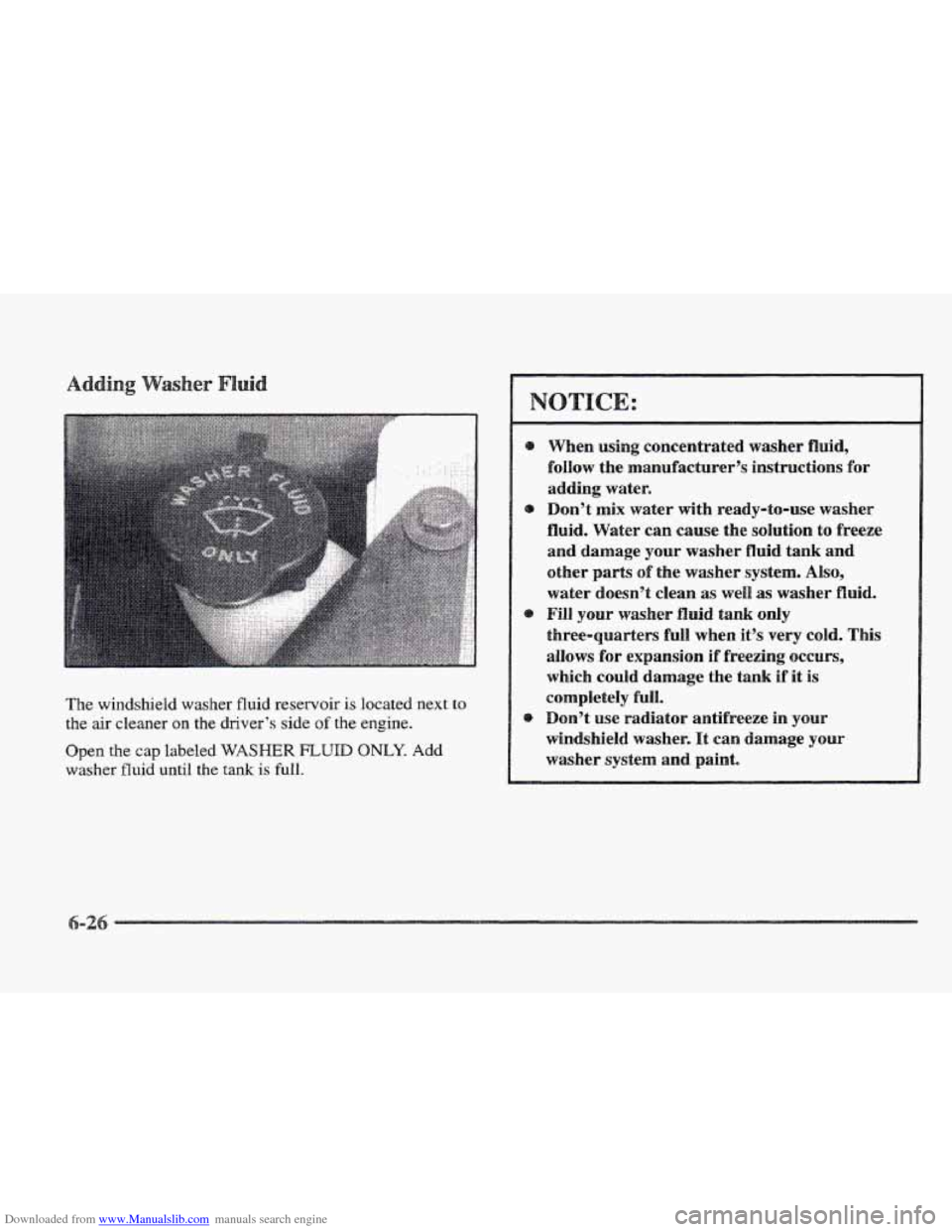
Downloaded from www.Manualslib.com manuals search engine The windsheld washer fluid reservoir is located next to
the air cleaner on the driver’s side of the engine.
Open the
cap labeled WASHER FLUID ONLY. Add
washer
fluid until the tank is full. When
using concentrated washer fluid,
follow the manufacturer’s instructions for
adding water.
Don’t
mix water with ready-to-use washer
fluid.
Water can cause the solution to freeze
and damage YOUS washer fluid tank and
other parts
of the washes system. Also,
water doesn’t clean
as well as washer fluid.
Fill your washer fluid tank only
three-quarters full when it’s very cold. This
allows for expansion if freezing OCCUTS,
which could damage the tank if it is
completely fulll.
Don’t use radiator antifreeze in your
windshield washer. It can damage your
washer system
and paint.
Page 290 of 361
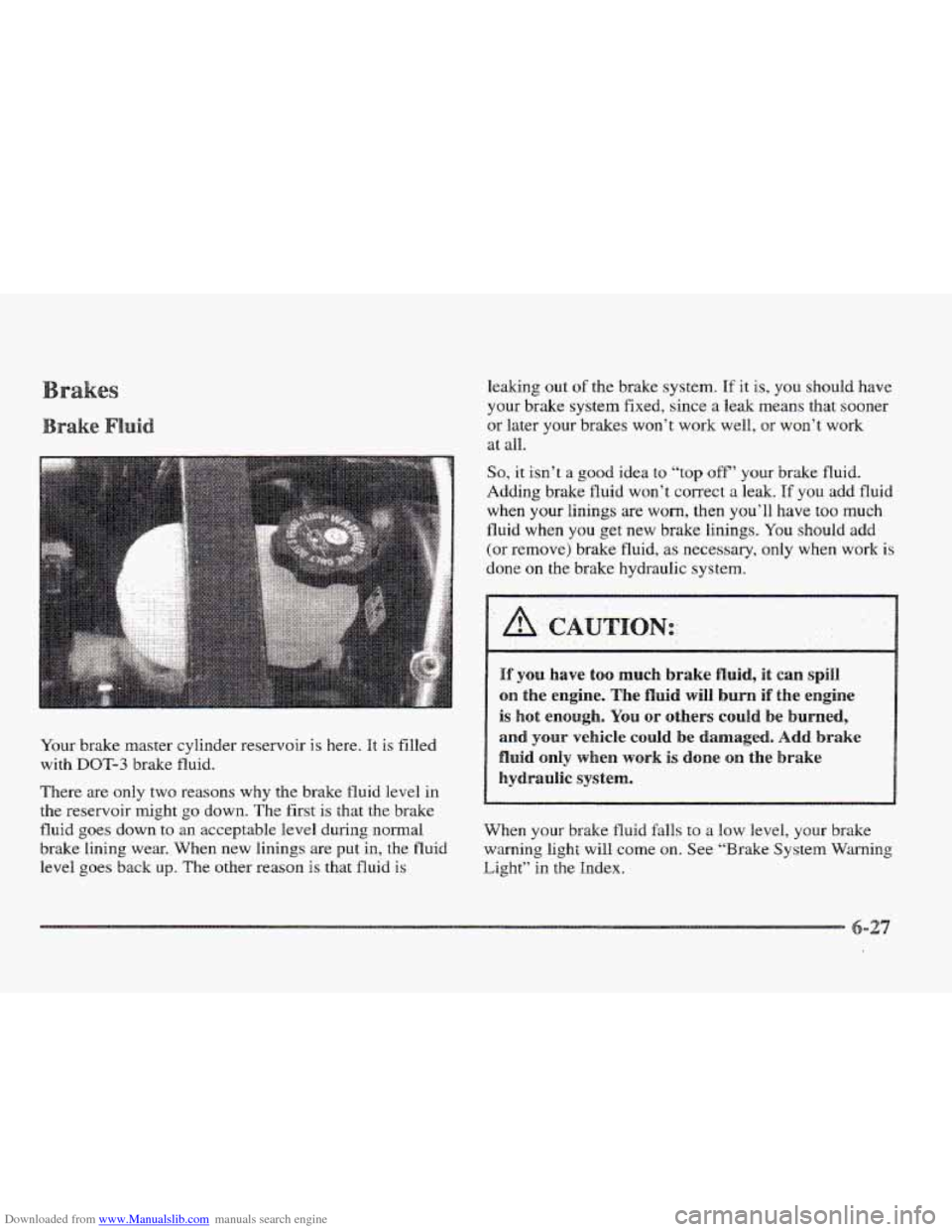
Downloaded from www.Manualslib.com manuals search engine Your brake master cylinder reservoir is here. It is filled
with
DOT-3 brake fluid.
There are only two reasons why the brake fluid level
in
the reservoir might go down. The first is that the brake
fluid goes down to an acceptable level during normal
brake lining wear. When new linings are put in, the fluid
level goes back up. The other reason
is that fluid is
leakng out of the brake system. If it is, you should have
your brake system fixed, since a leak means that sooner
or later your brakes won’t work well, 01- w~n’t work
at all.
so, it isn’t a good idea to “top off’ your brake fluid.
Adding brake fluid won’t correct a leak.
If you add fluid
when your linings are
worn, then you’ll have too much
fluid when you
get new brake linings. YOU should add
(or remove) brake fluid, as necessary, only when work is
done
on the brake hydraulic system.
When your brake fluid
falls to a low level, your brake
warning light will come on. See “Brake System Warning
Light” in the Index.